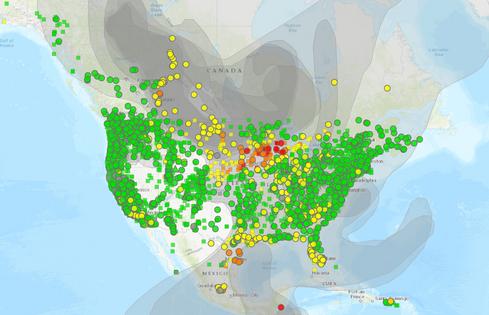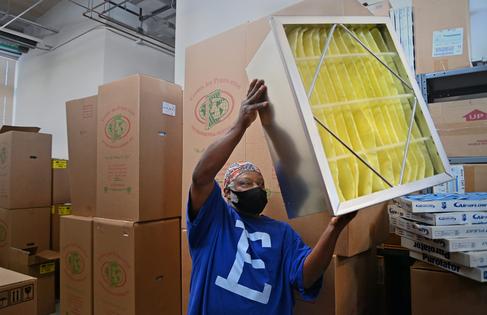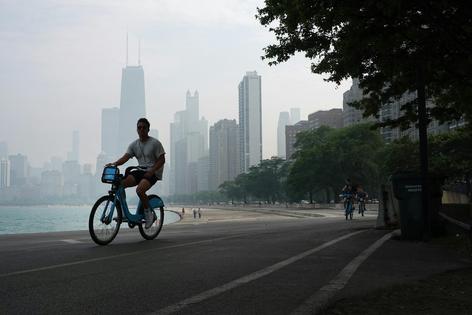Wildfire smoke is back – fires burning across Canada are already triggering US air quality alerts in the Midwest and Plains
Published in News & Features
Dozens of wildfires are burning across Canada in May 2024 and sending unhealthy smoke blowing into the northern U.S. again. At the same time, the southeastern U.S. is getting smoke from Mexico, where drought conditions have been fueling fires.
Last year, Canada’s record 2023 wildfire season introduced millions of Americans across the Midwest and northeastern states to the health hazards of wildfire smoke, with air quality alerts that reached levels never seen there before.
Professional baseball games were postponed and the skies in New York City turned orange with haze, at times exposing millions of people to the worst air quality in the world. In some regions, the smoke hung on for days.
The pressing question on many people’s minds: “Is this the new normal?” From our perspective as air quality scientists, we think the answer is likely “yes.”
Hotter, drier conditions, coupled with dry grasses and underbrush that accumulated over decades of fire suppression, have made large wildfires more common.
Canada is experiencing a second consecutive extremely dry year in 2024, and it is also facing the reemergence of fires that smoldered underground through the winter. May 12-14, 2024, smoke from fires in British Columbia and Alberta reached unhealthy levels from Montana to Wisconsin and began to spread south and east into the Midwest and Great Lakes region.
The North American Seasonal Fire Assessment and Outlook for May through July highlights drought conditions in western Canada and Central America and higher than normal fire risk in both regions. It also notes the challenge of forecasting fire risk for later in the year as the El Niño climate pattern transitions to La Niña in late summer.
Computer simulations of the future in a warming climate show there will be more smoky days, higher smoke concentrations, larger burned areas and higher carbon emissions from the fires – which further fuel climate change.
States and the Forest Service can use prescribed fires and forest thinning to help reduce the number and intensity of fire outbreaks, but smoke exposure is still likely to increase as temperatures rise and moisture levels change.
In short, people will need to learn to live with wildfire smoke. It won’t be every year, but it will be more common.
Fortunately, there are several tools and strategies for managing a smokier future.
Managing the risk of wildfire smoke starts with making smart personal choices.
Think of smoke waves like heat waves: They’re easier to face if you’re prepared and know they’re coming. That means paying attention to forecasts and having face masks, air monitors and clean-air shelters available.
Inhaling the particulate matter and the chemicals in wildfire smoke can exacerbate asthma, worsen existing respiratory and cardiac problems and leave people more susceptible to respiratory infection. People caring for individuals sensitive to smoke, such as young children and older adults, will need to plan for their needs in particular.
To prepare, read up on the risks and warning signs from public health professionals. Living with wildfire smoke may mean using air filtration devices, wearing N95 or KN95 masks on bad air days, modifying outdoor commuting patterns and activity schedules and changing household ventilation choices.
Living with smoke will also require changes to how schools, businesses, apartment buildings and government buildings operate.
Schools can start with setting a threshold for canceling outdoor activities and making sure staff are ready to meet the needs of kids with asthma.
Building managers may need to rethink air filtration and ventilation and deploy air quality sensors. Communities will also need contingency plans for festivals and recreation venues, as well as rules for business to protect outdoor workers.
Decisions on how to deal with smoke can be complicated. For example, selecting an air purifier can be a daunting task, with over 900 products on the market. The effectiveness of different smoke management interventions are not well known and can vary depending on small implementation details, such as how a mask fits the wearer’s face, whether exterior doors and windows seal tightly and whether filters are installed properly and are replaced often enough.
The U.S. has an extensive air quality monitoring and forecasting system to help provide some early warning. It uses ground-based air quality monitors, satellite remote sensing systems to detect smoke and fires and computer systems that tie observations together with wind, chemistry and weather. These are supplemented by expert guidance from meteorologists.
However, for average people trying to make decisions about the safety of outdoor activities, the current forecasting system is wanting. This is especially true when smoke blows in from fires far away, or when rapidly changing smoke emission rates and complex wind patterns lead to conflicting forecasts and advisories.
A few key improvements would go a long way for practical decision making around wildfire smoke. More accurate 10-day forecasts and neighborhood-level forecasts would help communities plan ahead. Merging seasonal weather forecasts of precipitation, humidity and winds with satellite assessments of wildfire fuel conditions could also enhance emergency planning.
Maintaining a strong air quality monitoring network is also important. However, state and local government agencies have reduced the number of ground monitors by about 10% from its peak in 2001. Smoke estimates from satellites and low-cost portable sensors can help, but they work best when they can be cross-calibrated to a well-maintained network of high-accuracy monitors.
More effective adaptations to smoke will require more research to better understand the effects of repeated exposures to wildfire smoke and the compound hazards that develop when smoke hits simultaneously with other challenges, such as extreme heat.
Community responses, such as providing clean-air shelters – the equivalent to a cooling center during extreme heat – are gaining attention, but there is only limited guidance on what constitutes a clean-air shelter and where and when one would be used.
Living with smoke is emerging as a new reality that people across much of North America will have to contend with again this year, and prepare for in the future.
This is an update to an article originally published Sept. 1, 2023.
This article is republished from The Conversation, a nonprofit, independent news organization bringing you facts and trustworthy analysis to help you make sense of our complex world. It was written by: Charles O. Stanier, University of Iowa; Gregory Carmichael, University of Iowa, and Peter S. Thorne, University of Iowa
Read more:
Wildfire smoke can harm human health, even when the fire is burning hundreds of miles away – a toxicologist explains why
Wildfire smoke and dirty air are also climate change problems: Solutions for a world on fire
Wildfire smoke changes dramatically as it ages, and that matters for downwind air quality – here’s what we learned flying through smoke plumes
Charles O. Stanier receives funding from the National Science Foundation.
Gregory Carmichael receives funding from the National Aeronautics and Space Administration.
Peter S. Thorne receives funding from the U.S. National Institutes of Health and the Burroughs Wellcome Fund.















Comments